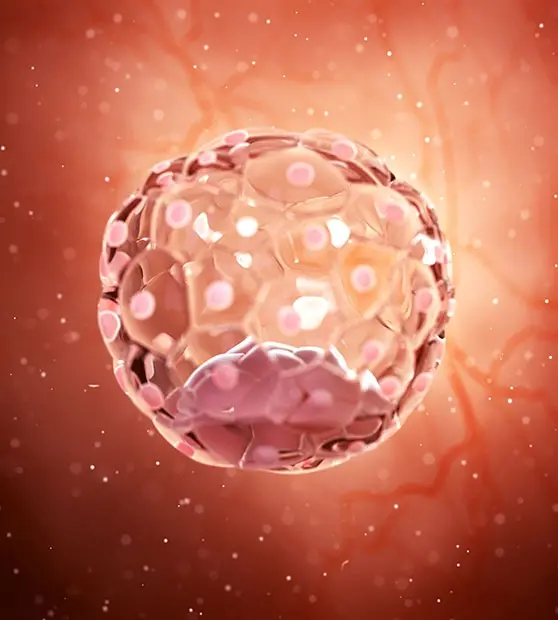How is frozen embryo transfer different from fresh transfers?
As the names suggest, a fresh cycle is when the embryo is transferred at the end of the IVF cycle, where only fresh embryos are transferred to the woman’s uterus. But in the frozen transfer, frozen and thawed embryos can be transferred months or even years after the egg retrieval.
Before understanding the procedures, it is crucial to know what is a blastocyst in IVF. On the fifth or sixth day post-fertilization, the embryo develops into a cell ball with two different types of cells. This is called a blastocyst which is the ideal stage for embryo transfer.
Both procedures begin similarly by monitoring the female’s ovulation and collecting the eggs once she is ready. The egg is fertilized with the sperm in the lab to form blastocyst embryos. The embryo is transferred within 3-5 days of retrieval in a fresh cycle. On the other hand, the embryos are preserved under freezing temperatures (cryopreservation) and thawed later for frozen-thawed transfer cycles.
What is the procedure for frozen cycle treatments?
Before transferring the cryopreserved embryos, the woman’s uterus is prepared to have the right endometrial thickness. This step ensures that the uterus receives the embryo in the best condition to accept it. The preparation can be either done through a natural process or hormone replacement therapy (HRT).
In the natural process, the doctors monitor the uterus, and once it reaches the required thickness, ovulation is induced. After about one week, the embryos are thawed and transferred to the uterus.
An HRT procedure involves medications like estrogen and progesterone to prepare the uterus. In human female, the blastocyst transfer time differs depending on the individual’s progress.
What are the blastocyst transfer success rates?
Frozen cycle success rates depend on several factors like your age and health. On average, frozen blastocyst implantation IVF has a 60% chance of pregnancy for every transfer. Though the success rate doesn’t majorly differ from that of fresh transfers, few studies suggest that frozen cycles have a higher chance of success. This is because the frozen cycle lets the female preserve embryos made from younger, healthier eggs (in most cases). A study has also shown that women having infertility issues related to PCOS had a higher birth rate using frozen cycles.
Is a frozen cycle better than IVF with fresh eggs?
Though the blastocyst transfer success rates are similar, FET has certain benefits when compared to fresh transfer procedures. Firstly, you can freeze the extra embryos from the fresh cycle. This will save you cost and effort as you don’t have to repeatedly go through the first part of the treatment.
Frozen cycles also offer more flexibility. You can decide when you want the transfer and have a planned pregnancy. If you want to get pregnant after the age of 35, this is especially beneficial as you can freeze healthy embryos beforehand at a younger age, when the quality of eggs will be better.
With frozen embryos, doctors can perform relevant tests to rule out any genetic abnormalities. This ensures that you get only high-quality, healthy, and genetically normal embryos transferred to your uterus, resulting in a better chance of having a healthy baby.
What precautions must we take before the procedure?
Frozen embryo transfer mainly involves the preparation of the uterus. If you are put on medications such as progesterone, it is important to take them on time. Other than that, you need to be happy and healthy both physically and mentally.
Avoid stress, eat a healthy diet, and get adequate sleep. If you feel anxious about the procedure, you can practice meditation to keep your mind calm. Reduce your caffeine intake and avoid alcohol and tobacco during the treatment. Talk to your doctor if you are taking any other medication.
Go to the clinic with a full bladder as it alters the angle to the uterus, making access easier. It is best to ask the doctor if you have any doubts regarding the procedure. Talking to the doctor can also help you understand some technical questions regarding FET, such as “what is a blastocyst?” or “When does an embryo turn into a blastocyst?”
What is it like after the embryo transfer?
Usually, you will be asked to rest for 10-15 minutes in the clinic post embryo transfer. After that, you can go back to your everyday activities and even resume work on the same day. But few clinics also suggest their patients rest for a day or two. While it is okay to exercise after the transfer, it is best to avoid any strenuous activity. Gentle exercises such as yoga or walking are best as they keep you active while avoiding strain.
You need to take care of your health and avoid alcohol and tobacco, as you could be pregnant after embryo transfer. It is best to also avoid sex for a few days post transfer, as it could cause your uterus to contract, hindering your chances of implantation.
Even though it is tempting, avoid taking a pregnancy test within the first few days of the procedure. The hormones could give a false-negative result, which can be upsetting. Ideally, you should take a pregnancy test on the date suggested by your IVF specialist.
Is it normal if I bleed after an embryo transfer?
Bleeding after an embryo transfer is often mistaken for periods. But this can also be implantation bleeding. The implantation bleeding is caused due to rupture of blood vessels in the uterus during the embryo implantation. This bleeding is lighter and is completely normal.
Have more questions about FET?
Consult a doctor at ART Fertility Clinics. At ART Fertility Clinics, we have experienced doctors and advanced technology that has helped several couples experience the joy of parenthood. We have amongst the highest pregnancy rates globally, and we take utmost care to provide you with the best treatment at our clinics. With ART Fertility Clinics, you are in safe and experienced hands for your IVF treatments. Our clinics are present in India, UAE & Oman.



